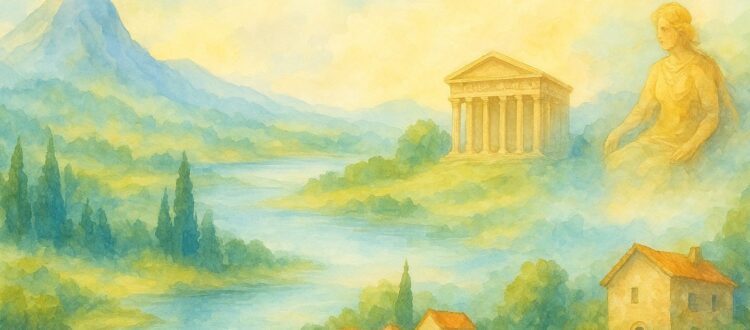Allure Of Watercolour Painting: A Dance with Water and Pigment
Imagine walking into an art gallery and being captivated by artworks with ethereal transparency and luminous glow. There’s something magnetic about a pool of colour on damp paper, edged with subtle blurs and luminous washes. There’s a whisper of magic in the way colours bloom and bleed on paper, a delicate yet profound artistry that captures light and emotion with breathtaking transparency.
In a world saturated with bold acrylics and digital prints, watercolour remains a whispering alternative: light, responsive, intimate. Let’s step into its world — what it is, how it developed, why it endures, and how India has embraced it.

Also Read: The Art of Paper: Guide to Paper Artworks
What is Watercolour Painting?
Watercolour painting is a style of painting that uses a medium of vegetable glue, diluted with water. The result: transparent or semi-transparent layers, fluid washes, soft edges, and often a luminous glow when the light passes through the layers of paint and reflects off the paper. Unlike oil or acrylics, which sit opaquely on the surface, watercolour pigments are transparent, allowing the white of the paper to reflect through and create luminosity. This transparency is watercolour’s defining characteristic. The medium is known for its quick-drying nature and portability, making it ideal for capturing scenes en plein air (outdoors) or for quick sketches.
History Of Watercolour Painting

The history of water-based pigments can be traced back to antiquity.
Watercolour art dates from Stone Age cave painting, where painted pictures of animals and humans were found on the walls of caves, using charcoal, ochre and other natural pigments.
Ancient Egyptians used tempera, a form of water-based paint, for tomb decorations and papyrus illustrations.
Ancient and medieval origins
- Ancient use: Watercolour-like techniques date back to ancient times, with examples found in Egyptian papyri and prehistoric cave paintings.
- Medieval manuscripts: During the Middle Ages, watercolours were used to create illuminated manuscripts and colour maps in Europe.
- Renaissance exploration: Artists like Albrecht Dürer in the 15th and 16th centuries explored watercolour’s potential for detailed studies of nature, wildlife, and landscapes.
The Golden Age in Britain: From Sketch to Masterpiece

Watercolour painting has a rich history in Britain, dating back to the early 1700s.
The Rise of the 18th century marked a significant turning point for watercolour. In England, particularly, its popularity surged. Topographical artists and illustrators found it perfect for documenting landscapes, architecture, and scientific subjects. This era saw the rise of prolific artists like Paul Sandby, often dubbed the “father of English watercolour,” who used the medium to depict detailed scenes of the British countryside.
Watercolour Painting Techniques

Watercolour’s expressive power hinges on how pigment, water, and paper interact. Here are some well-known watercolour painting techniques:
- Washes: These are broad applications of diluted pigment.
- Flat Wash: An even application of a single colour over an area.
- Gradated Wash: A wash that transitions smoothly from dark to light or one colour to another.
- Wet-on-Wet: Applying wet paint onto a wet surface. This technique creates soft, diffused edges and allows colours to blend organically on the paper, often resulting in beautiful, unpredictable effects.
- Wet-on-Dry: Applying wet paint onto a dry surface. This offers more control and produces sharper edges and crisper details.
- Dry Brush: Using a brush with very little paint and minimal water on a dry surface. This creates textured, broken lines and granular effects, perfect for rendering rough surfaces or atmospheric details.
- Mixed media interplay: Watercolour combined with other media (ink, charcoal, pastel) for variation.
- Pull in Colour: This technique requires you to paint a heavy line of colour with a dry brush, and then use a clean wet brush to pull the colour across the canvas.
- Lifting: Removing wet or dried paint from the paper using a damp brush, sponge, or tissue to lighten an area or create highlights.
- Masking: Using masking fluid to protect areas of the paper from paint, preserving the white of the paper or a previously painted layer.
- Glazing: Applying transparent layers of colour over dried layers. This builds up depth and rich, luminous colours without making the painting appear muddy.
- Salt Technique: Sprinkling salt onto wet watercolour creates interesting starburst or crystalline patterns as the salt absorbs the pigment and water.
Watercolour Painting in India

Watercolour painting in India has a long history, from ancient natural pigments on cave walls to the intricate miniature paintings of the medieval period and the influence of European styles during colonial times. Today, it’s a vibrant and evolving art form that captures India’s culture, landscapes, and everyday life.
Famous Watercolour Painters in India
India has produced a pantheon of remarkable watercolour artists, each contributing uniquely to the medium’s legacy:
- Abanindranath Tagore (1871-1951): A pivotal figure in the Bengal School, known for his “wash technique” that created soft, evocative atmospheric effects, often depicting mythological and historical subjects.
- Nandalal Bose (1882-1966): A student of Abanindranath Tagore, Bose was a master of various media, including watercolour.
- Gaganendranath Tagore (1867-1938): Brother of Abanindranath, Gaganendranath was an innovator who explored cubism and satirical cartoons, often using watercolour to render his unique visions.
- Jogen Chowdhury (b. 1939): A contemporary master, Chowdhury’s distinctive style, often characterised by cross-hatching and curvilinear forms, extends to his watercolours, which possess a raw intensity and psychological depth.
Giftex Upcoming Modern and Contemporary Art Auction
For art enthusiasts and collectors, the upcoming Giftex Modern and Contemporary Art Auction this November presents a unique opportunity to engage with significant artworks. Auctions like these are vital platforms for discovering emerging talent, acquiring works by established masters, and participating in the vibrant art market. This upcoming art auction signals the healthy market interest in fine-art works in India. Collectors are increasingly attuned to quality, medium, provenance and significance. Keep an eye on the Giftex website and blogs for announcements on dates, previews, and catalogues to explore the diverse range of artworks that will be available. Such events provide a tangible connection to the art world, allowing both seasoned collectors and new patrons to appreciate and invest in the rich legacy of art.
Conclusion: The Ever-Flowing Current of Creativity
Watercolour painting, with its ancient roots and continuous evolution, remains a captivating art form. This is more than a “light sketch medium.” It is a richly expressive vehicle with centuries of history and a vibrant place in today’s art world. Its inherent qualities — transparency, immediacy, responsiveness — make it compelling. In India, watercolour has been adapted to the local terrain, light, tradition and contemporary sensibility. For collectors and enthusiasts alike, the appeal remains: a work in watercolour offers both subtlety and impact. As auctions like Giftex’s highlight the value of fine art in the Indian scene, it’s a good moment to pay attention — whether as an artist, collector or viewer.






